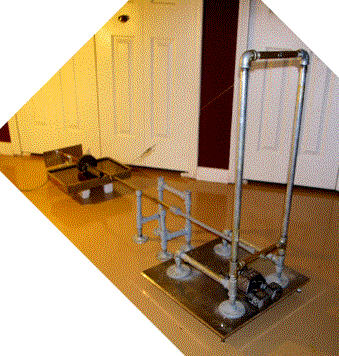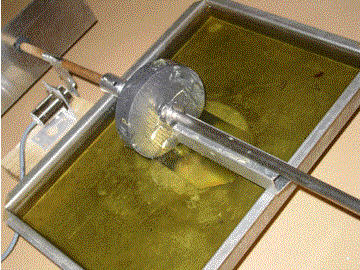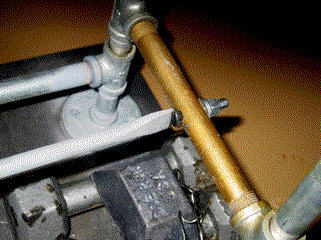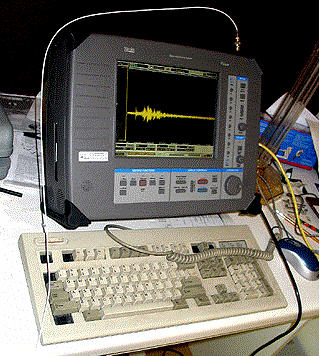
Figure 1. Lehman Seismometer
The boom is a horizontal pendulum. It
has a period of 14.2 seconds, equivalent to a natural frequency
of 0.071 Hz. A sensor at the free end measures the displacement.
The boom length is 64 inch. The total frame height is 35 inch.
The boom has a knife edge that pivots against a bolt head in
the lower cross-beam of the frame.
The boom is suspended from the frame by
a wire cable. The cable is attached to the top cross-beam of
the frame. The other end of the cable is attached to the boom,
about two-thirds of the distance from the pivot to the free end
of the boom. The pivot point is offset from the top cable attachment
point. Thus, the boom oscillates as if it were a "swinging
gate."
The plate supporting the frame has three
adjustable mounting feet. The feet can be adjusted to tune the
pendulum to the desired natural frequency. Furthermore, the wire
cable has a turnbuckle which is used to adjust height of the
free end of the boom.
The detached frame in the center of the
figure is used for assembly and to limit the displacement during
tuning.

Figure 2. Sensor and Damping Method
The sensor is the metal cylinder mounted
in the L-bracket at the left, center of the image.
The
sensor is a non-contact inductive linear displacement transducer. The
model is Omega LD701-5/10 with a 5-10 mm range. The
sensor outputs a voltage proportional to the distance from the sensor
head to the steel target, which is suspended underneath the wooden rod
section of the boom.
The inductive sensor was my third, and
by far most successful, measuring solution. I highly recommend
this transducer.
The first sensor was a linear variable
displacement transducer (LVDT) with its spring removed. The LVDT,
however, had too much friction which increased the natural frequency
of the boom to an unacceptable value.
The second sensor was a magnetic coil
attached to the boom. The coil moved between the poles of a magnet,
thus inducing a voltage proportional to the velocity. This is
the classic sensor method used with most Lehman seismometers.
The signal requires tremendous amplification. Regretfully, my
coil, magnet, and amplifier set-up missed the Parkfield, California
earthquake. This setback led me to the inductive displacement
sensor, which has proven to be successful.
The lead disk is used for ballast. The
pan contains canola oil which is used for viscous damping, both
in the vertical and horizontal axes. A horizontal plate is connected
to the disk and is fully submerged in the oil. Furthermore, the
bottom side of the disk dips into the oil. The resulting viscous
damping is 9.8%.
The thin aluminum plate at the free end
of the beam was used for an alternative damping method that was
abandoned in favor of the oil method.

Figure 3. Pivot End of the Boom
This end of the boom is actually a chisel
blade. Its edge butts up against a chrome plated bolt head. Ballast
weights are located on the plate below the pivot point.

Figure 4. Nicolet Vision Data Acquisition
System
The trace is the displacement time history
of the Solomon Islands earthquake on October 8, 2004 as measured
by the Lehman seismometer via the inductive sensor. The magnitude
was 6.8. The seismometer is located at home in Mesa, Arizona.
I use this same acquisition system for
measuring pyrotechnic shock in launch vehicle stage separation
tests. I also use it for rocket nozzle frequency response tests.
The Nicolet is a completely gold-plated
Cadillac solution for the Lehman seismometer, but I wanted to
do this science project with some style.
The Nicolet sample rate is set to 50 samples
per second. Its lowpass filter is set to 5 Hz.
A
Krohn-Hite filter, model 3343, is used to highpass filter the
displacement signal at 0.03 Hz prior to its input to the Nicolet
system. It also provides a 20 dB gain.
The following table lists of some of the
notable quakes measused on this seismometer.
Date (Year 2004)
|
Magnitude
|
Location
|
Report
|
|
November 20 |
6.2 |
Costa Rica |
|
|
November 15 |
7.2 |
Colombia |
|
|
November 2 |
6.5 |
Vancouver Island |
|
|
October 15 |
6.7 |
Taiwan |
|
|
October 8 |
6.8 |
Solomon Islands |
|
|



